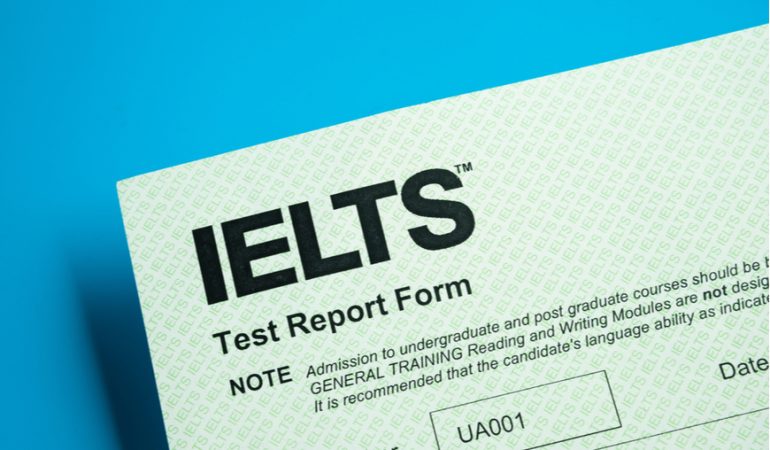IELTS(International English Language Test System), established in 1989 and jointly managed by the British council, IDP, and Cambridge Assessment English, is a globally recognised English language proficiency test. It is one of the major English language proficiency tests accepted by most academic institutions worldwide that accept English as their native or organisational language.
What are the types of IELTS?
IELTS is categorised into two types, Academic and General Training.
Academic IELTS is for those who want to study at a university level in English-speaking countries. It can be attempted from both home and test centres. Paper and computer-based tests are accepted at test centres, while online tests can also be attempted from home.
General training IELTS is for those who want to work, train, study at secondary school or migrate to English-speaking countries. Paper and computer-based tests are accepted at test centres, but attempting to test online from home is not accepted.
Test format of IELTS
The syllabus of IELTS is divided into four parts; listening, reading, writing and speaking. Both academic and general training IELTS carry the same listening and speaking skills, but differences can be noticed in reading and writing tests. One needs to attempt listening, reading and writing the same day with no breaks but speaking tests, depending on the test centres, might be organised a week before, after or the same day. If you are giving a test online, speaking will occur before other tests.
Listening
This part consists of 4 sections with ten questions in each section, and 30 minutes is allocated to accomplish this task. A conversation between two people in an everyday context, a monologue in an everyday social context, a conversation between two to four people in an educational context and a monologue on an academic subject are the contents of the listening part.
Multiple choice, matching, plan/map/diagram labelling, summary completion, sentence completion and answering short questions are the types of questions required to be answered for IELTS listening.
Reading
Both academic and general training reading contains three sections with 40 questions, and one needs to accomplish this task in 60 minutes.
Academic Reading: It consists of three long texts from books, journals, newspapers and magazines that are of general interest. Tasks to be accomplished in academic reading are matching information/headings, answering multiple choice questions, giving short answers, sentence completion, summary/note completion, table/flow-chart/diagram label completion and identifying the writer’s views/claims.
General Training Reading: One should go through two, three or several short texts in the first section, two texts in the second section and one long text in the third section. Texts are extracted from fictional and non-fictional books, magazines, notices, newspapers, company handbooks and advertisements. Matching headings to written text or diagram, multiple choice questions, matching headings/information/features, matching sentence endings, sentence/summary completion, note/table/flow-chart/diagram label completion and giving short answers are the types of tasks to be accomplished.
Writing
Both academic and general training writing contains two tasks and needs to be completed within 60 minutes.
Academic Writing: For task 1, you will be given a graph, table, chart or diagram and need to explain the information, describe the process stages or summarise in your own words. 150 words in formal or academic style are required to complete this task, but bullet points and notes are not accepted as answers. Task 2 is about writing an essay on the given topic. At least 250 words in academic or formal style are required to complete this task. Well-organised ideas, examples and language accuracy are the things to be considered while writing an essay.
General Training Writing: Topics of general interest are asked in general training writing. For task 1, a situation will be delivered, and you will need to write a personal response in the form of a letter asking for information or explaining the situation with at least 150 words. You can write in an informal, semi-formal or formal style. For task 2, you must write an essay on a topic consisting of 250 words or more. Personal style can be used for writing, but ideas need to be organised, and details to arguments should be provided.
Speaking
This part is divided into three parts, and you will be given 11-14 minutes for this part. You will talk to a certified IELTS examiner, and the test will be recorded. The examiner will see language accuracy, coherence, way of organising ideas, and how you deliver your opinion on everyday topics.
The first part includes an introduction and general questions on home, family, studies, hobbies and interests. Secondly, you will be given a topic with 1 minute time to prepare for the topic and need to keep talking for 1-2 minutes without interruption. Finally, further questions connected to the topic will be asked to discuss ideas.
Some of the test centres offer the video-call speaking test.
The scoring system of IELTS
There is no term pass or fail in IELTS; one can score between 1-9 band. In addition, one secures independent band in listening, reading, writing and speaking. There are 1-9 bands for all categories; the final band is calculated from the average of four individual scores.
For example,
| Listening | Reading | Writing | Speaking | Average Band | Overall Band |
| 6.5 | 7.5 | 7 | 6 | 6.75 | 7 |
| 7 | 7.5 | 7 | 7 | 7.125 | 7 |
| 5.5 | 7 | 6.5 | 6 | 6.25 | 6.5 |
If the average score ends at .75, then the score will be the next whole band. If it ends at .125, the score will be the previous whole band, and if it ends at .25, the score will be the next half band.
In listening and reading, one mark is allocated for each question, and total 40 marks are for 40 questions. The obtained score from 40 is then converted to a band of 9.
In Writing, Examiner gives score based on task achievement/task response, coherence/cohesion, lexical resource and grammatical accuracy/range. Each criteria carries an equal point, and the average is taken of all.
Similarly, in speaking, the score is calculated based on fluency/coherence, lexical resource, pronunciation and grammatical range/accuracy.
Kindly, Visit Our Sites for More Information.





